- My Trading Psychology
- Posts
- Why There Are No Gazillionaires
Why There Are No Gazillionaires
The point where size breaks psychology
Every trader has done it at least once.
You open Excel, type in a starting balance, add one percent a day, drag the formula down, and watch the curve rise like a rocket.
A thousand becomes a million. A million becomes a billion.
It looks so clean that you start to believe it could actually happen. But it never does.
No trader has compounded their way to a gazillion. Not even close. Why?
There are two reasons, and everyone who has ever touched a low-liquidity stock knows the first one well: at a certain size, you start moving the price. It takes a lot of money to have any impact on high-liquidity stocks, futures, and commodities, but eventually it’s a question of your account size’s ratio to the daily volume of the instrument you are trading.
In some cases, it will take hundreds of millions or even more, but your trades will start impacting the price of anything.
It may sound like a strange problem, but if you have ever watched Kristjan Qullamaggie live streams, you have a good example of a successful trader struggling to find stocks to trade at his nearly $100M account size because his buy and sell orders clean up the order book at depth.
But the second reason why most of the traders don’t ever get even close to the Kristjan Qullamaggie’s sizing problem is surprisingly psychological.
The Real Limit: The Mind Adapts Slower Than The Account
As a successful futures trader Adam Mancini wrote, each level of size requires a different psychology.

If you’ve ever traded with different position sizes, you’ve felt it.
At small size, you can take a setup freely. You’re focused on execution.
At larger size, you start to hesitate more. Losses that once felt tolerable now feel personal. Your brain starts calculating the pain before the trade even moves.
That’s where compounding breaks.
The math says it’s just a number. The mind feels it as a threat.
Your nervous system doesn’t scale linearly. It reacts to risk in chunks. Each jump in size resets your emotional baseline. Until your psychology catches up, your behavior changes. And usually in ways you don’t notice.
You tighten stops that shouldn’t be tightened. You skip trades that used to be automatic. You hold losers too long, hoping to avoid admitting a bigger mistake.
And just like that, the smooth spreadsheet curve is gone.
When Success Becomes the Enemy
Many traders who strike gold have experienced this firsthand.
They make a few great trades, their account explodes tenfold, and suddenly they’re playing a completely different game without realizing it.
Their setups didn’t change, but their perception of those setups did. The same chart patterns now carry different emotional weight. And most aren’t ready for it.
So the story repeats: quick rise, faster fall.
Not because of bad setups, but because of unadjusted psychology.
The Real Lesson
Compounding isn’t just about the money.
It’s about compounding mental capacity.
Every step up in size demands a new layer of calm, patience, and detachment. Very few make that leap more than once.
The smartest traders acknowledge this threshold and stick to the size that is psychologically comfortable for them.
You can only be a successful trader if your setups and edge work. And they work only if you’re always mentally on top of your trades.
That’s why there are no gazillionaires in trading.
Because size tests the mind faster than it rewards it. And most fail that test.
Share this post with someone who starts acting weird after their account sizes up.
Reply